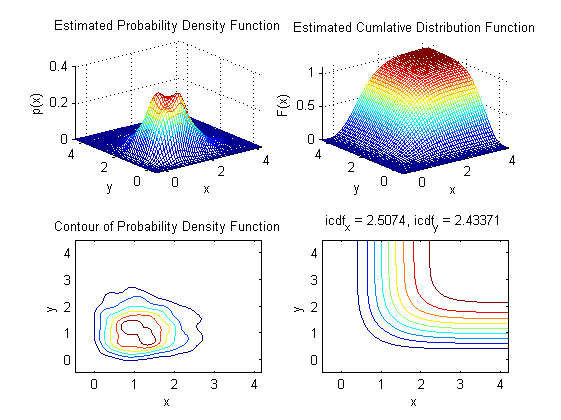Bivariate Kernel Density Estimation Demonstration
Several examples show how to use the gkdeb2 function.
Contents
- Distribution with unbounded support
- Distribution with upper and lower bounds: uniform distribution
- Distribution with lower bound only: exponential distribution
- Distribution with lower bound only: log-normal distribution
- Distribution with lower bound only: chi-square distribution
- Distribution with lower bound only: Rayleigh distribution
Distribution with unbounded support
Distribution with four peaks.
x = [randn(100,1), (randn(100,1)-10)*2;
randn(100,1)+10, randn(100,1);
randn(100,1)+10, (randn(100,1)-10)*2;
randn(100,2)];
gkde2(x);

Distribution with upper and lower bounds: uniform distribution
clear x=rand(10000,2); % PDF with bounded support p.xylim=[0 0 1 1]; gkde2(x,p); % Compare with unbounded PDF estimate figure; gkde2(x);


Distribution with lower bound only: exponential distribution
clear x=-log(rand(1000,2)); % PDF with bounded support p.xylim=[0 0 Inf Inf]; gkde2(x,p); % Compare with unbounded PDF estimate figure gkde2(x);


Distribution with lower bound only: log-normal distribution
clear x=exp(randn(1000,2)); % PDF with bounded support p.xylim=[0 0 Inf Inf]; gkde2(x,p); % Compare with unbounded PDF estimate figure gkde2(x);


Distribution with lower bound only: chi-square distribution
clear x=randn(1000,2).^2; % PDF with bounded support p.xylim=[0 0 Inf Inf]; p.alpha=0.95; gkde2(x,p); % Compare with unbounded PDF estimate figure p1.alpha=0.95; gkde2(x,p1);


Distribution with lower bound only: Rayleigh distribution
clear x=sqrt(randn(2,1000).^2 + randn(2,1000).^2); % PDF with bounded support p.xylim=[0 0 Inf Inf]; p.alpha=0.95; gkde2(x,p); % Compare with unbounded PDF estimate figure p1.alpha=0.95; gkde2(x,p1);

